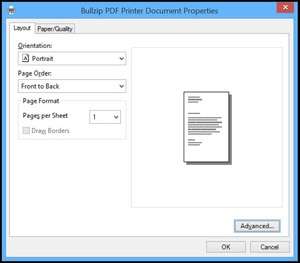

- How to make a pdf smaller using bullzip update#
- How to make a pdf smaller using bullzip free#
- How to make a pdf smaller using bullzip windows#
That was not going to work, for files scattered among many folders.
How to make a pdf smaller using bullzip windows#
It showed me the usual Windows Explorer type of dialog, where I could select individual files. I went into the Merge/Extract plugin and clicked its Add button. I had to use Revo Uninstaller to get rid of it.Īnyway, I began with the PDFsam GUI. Unfortunately, Soda did not want me to uninstall it. Nice to know it existed, if I was looking for an alternative to Acrobat but at the moment, at least, I was sticking with freeware. I was not paying attention during the sneaky installation process, I clicked on the wrong thing and found myself saddled with Soda. I downloaded and installed PDF Sam 2.2.4. It had been a while since I had used PDFsam. PDFsam was not a PDF tester, but I thought it might identify PDFs that were too corrupt to merge. This tool was PDF Sam (short for split-and-merge). To test that, I decided to try using a different kind of tool. I wanted to see if other programs would find corrupted PDFs that CorruptedPDFinder had overlooked. In a few cases, I got the error message just shown, when I tried to open them in Acrobat but for most, the error message was this:Īcrobat could not open because it is either not a supported file type or because the file has been damaged.įinding these corrupted files led to a separate pursuit, described in another post, in which I explored various PDF repair options. I would have liked right-click options to delete individual files, and to output the list of files to a text file, but at least CorruptedPDFinder did offer options to delete the corrupted files or to move them to another folder.Īltogether, from the whole set of 55,000 PDFs, CorruptedPDFinder identified a total of 34 corrupt files. The file is damaged and could not be repaired. There was an error opening this document. When I did that, Adobe Acrobat (my PDF reader) gave me an error message: It allowed me to open that PDF - or, I should say, to attempt to open it - by double-clicking on that entry in the list. It quickly scanned a designated folder, and its subfolders, and detected one problematic PDF out of a total of 221. My first 1 2 3 4 searches led to a program called CorruptedPDFinder, available on Softpedia under the awkward name of Recursive Finder of Corrupted PDF Files. Another post provides a partial simplification of certain key points discussed below. Even so, portions of this post may be useful for those seeking a tutorial in batch programming, as many steps are explained in detail. This testing proceeded in fits and starts over a period of months thus, some sections or comments may be inconsistent with others. The following notes may be haphazard in places. The largest set tested here consisted of about 55,000 random PDFs. (I was using Windows 7, though other Windows and in some cases non-Windows operating systems would also be able to use techniques discussed here.) I tried these approaches on small and large sets of PDFs from various sources.
How to make a pdf smaller using bullzip update#
Several years earlier, I had posted a writeup of similar efforts now I wanted to update that and see if there were any relevant new tools or techniques. I wanted to see if any of them were corrupt. I had a large number of PDF files scattered around my drive. In both the printing and non-printing approaches, the following text raises many thoughts and points out many technicalities that may be of interest to others who seek good PDF-testing tools. That said, it appeared that the non-printing alternatives discussed below were at least representative if not dominant among the possible approaches available to most users. No doubt there are many other printing and non-printing approaches than are explored here.
How to make a pdf smaller using bullzip free#
Some portions of this post explore non-printing alternatives, both free and commercial. It seemed that readable but partly corrupted PDFs would be especially susceptible of detection when every page of every PDF was being run through a printer, even if the output was purely digital. While I found those PDF-printing approaches to be far slower than the CorruptedPDFinder and Acrobat approaches, they had an advantage of thoroughness. Most of this post explores various PDF-printing approaches, leading up to the choice of that Adobe Reader approach as the best of the lot. For more information on that command-line option, see the Recap at the end of this post. I found three that worked: CorruptedPDFinder the File > Create PDF > Batch Create Multiple Files procedure within Adobe Acrobat and a command-line PDF-printing approach using Adobe Reader.


I looked for ways to test large numbers of PDFs in Windows 7. Note: a later post provides a short version of key points from this post.


 0 kommentar(er)
0 kommentar(er)
